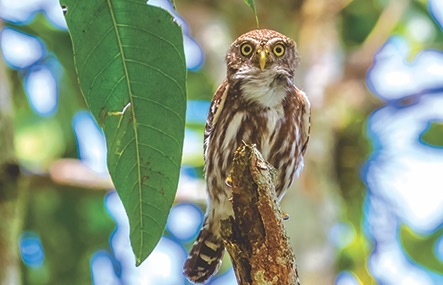With more than 850 species of resident and migrant birds identified throughout the country, Costa Rica abounds with great bird-watching sites. Lodges with the best bird-watching include Savegre Hotel (www.savegre.com) in Cerro de la Muerte, off the road to San Isidro de El General (quetzal sightings are almost guaranteed); La Paloma Lodge in Drake Bay, where you can sit on the porch of your cabin as the avian parade goes by; Arenal Observatory Lodge on the flanks of Arenal Volcano; La Selva Biological Station in Puerto Viejo de Sarapiquí; Selva Bananito Lodge, north of Cahuita; Lapa Ríos and Bosque del Cabo, on the Osa Peninsula; Playa Nicuesa Rainforest Lodge along the Golfo Dulce; La Laguna del Lagarto Lodge near the Nicaraguan border; and Tiskita Jungle Lodge near the Panamanian border.
Some of the best parks and preserves for serious birders are Monteverde Cloud Forest Biological Reserve (for quetzals and hummingbirds); Corcovado National Park (for scarlet macaws); Caño Negro Wildlife Refuge (for wading birds, including jabiru storks); Wilson Botanical Gardens and Las Cruces Biological Station, near San Vito (the thousands of flowering plants here are bird magnets); Guayabo, Negritos, and Pájaros Islands biological reserves in the Gulf of Nicoya (for magnificent frigate birds and brown boobies); Palo Verde National Park (for ibises, jacanas, storks, and roseate spoonbills); Tortuguero National Park (for rare green macaws); and Rincón de la Vieja National Park (for parakeets and curassows). Rafting trips down the Corobicí and Bebedero rivers near Liberia, boat trips to or at Tortuguero National Park, and hikes in any cloud forest also provide good bird-watching opportunities.
In San José, your best bets are to head toward the lush grounds and gardens of the University of Costa Rica, or to Parque del Este, a little farther east in the foothills just outside of town.
Costa Rican Birding Tours
Costa Rica Expeditions (www.costaricaexpeditions.com; tel. 2221-6099) and Costa Rica Sun Tours ★ (www.crsuntours.com; tel. 800/359-1884 in the U.S. and Canada, or 2296-7757 in Costa Rica) are well-established companies with very competent and experienced guides who offer a variety of tours to some of the better birding spots in Costa Rica.
International Birding Tours
Costa Rica Focus (www.costaricafocus.com; tel. 888/788-4272 in the U.S. and Canada) is a Costa Rica based operator with a variety of specialized bird-watching trips that focus on photography, beaches, biological stations, and country highlights. Some of their offerings are geared to budget travelers, and first time visitors to Costa Rica.
Field Guides (www.fieldguides.com; tel. 800/728-4953 in the U.S. and Canada) is a specialty bird-watching travel operator. Its 15-day tour of Costa Rica covers a lot of ground, and group size is limited to 12.
Tropical Birding (www.tropicalbirding.com; tel. 800/348-5941 in the U.S. and Canada), specializing in birding tours around the world, is based in Ecuador but periodically brings small groups and highly skilled guides to Costa Rica.
Victor Emanuel Nature Tours (www.ventbird.com; tel. 800/328-8368 in the U.S. and Canada) is a well-respected, longstanding, small-group tour operator specializing in bird-watching trips.
WINGS (www.wingsbirds.com; tel. 866/547-9868 in the U.S. and Canada) is a specialty bird-watching travel operator with more than 30 years of field experience. Group size is usually between 4 and 16.
Where to See the Resplendent Quetzal
Revered by pre-Columbian cultures throughout Central America, the resplendent quetzal has been called the most beautiful bird on earth. The ancient Aztecs and Mayans believed the robin-size quetzal protected them in battle. The male of the species has a brilliant red breast, an iridescent emerald head, back, and wing; and white tail feathers complemented by a pair of iridescent green feathers that are more than .5m (1[bf]3/4 ft.) long.
The belief that these endangered birds live only in the dense cloud forests cloaking the higher slopes of Central America’s mountains was instrumental in bringing many areas of cloud forest under protection as quetzal habitats. (Since then, researchers have discovered that the birds do not, in fact, spend their entire lives here.) After nesting between March and July, the quetzals migrate to lower slopes in search of food. These lower slopes have not been preserved in most cases, and now conservationists are trying to salvage enough lower-elevation forests to help the quetzal survive.
Although for many years Monteverde Cloud Forest was the premier place to see quetzals, the “crowd forest” that has thronged to visit makes sightings less frequent. Other places where you can see quetzals are in the Los Angeles Cloud Forest Reserve near San Ramón, in Tapantí National Wildlife Refuge, and in Chirripó National Park. Perhaps the best place to spot a quetzal is at one of the specialized lodges located along the Cerro de la Muerte between San José and San Isidro de El General.
Note: This information was accurate when it was published, but can change without notice. Please be sure to confirm all rates and details directly with the companies in question before planning your trip.









